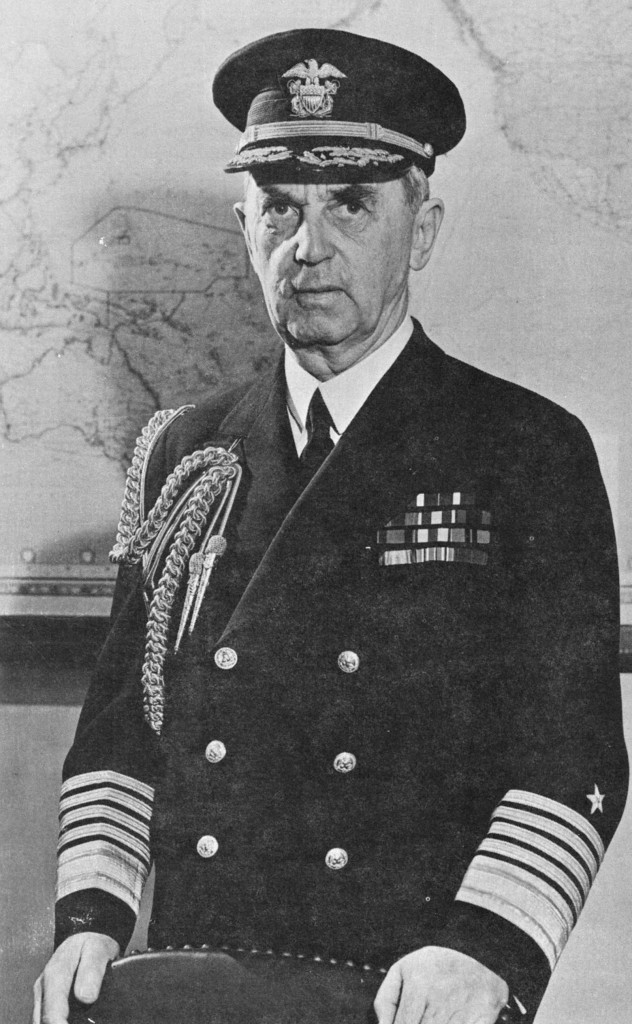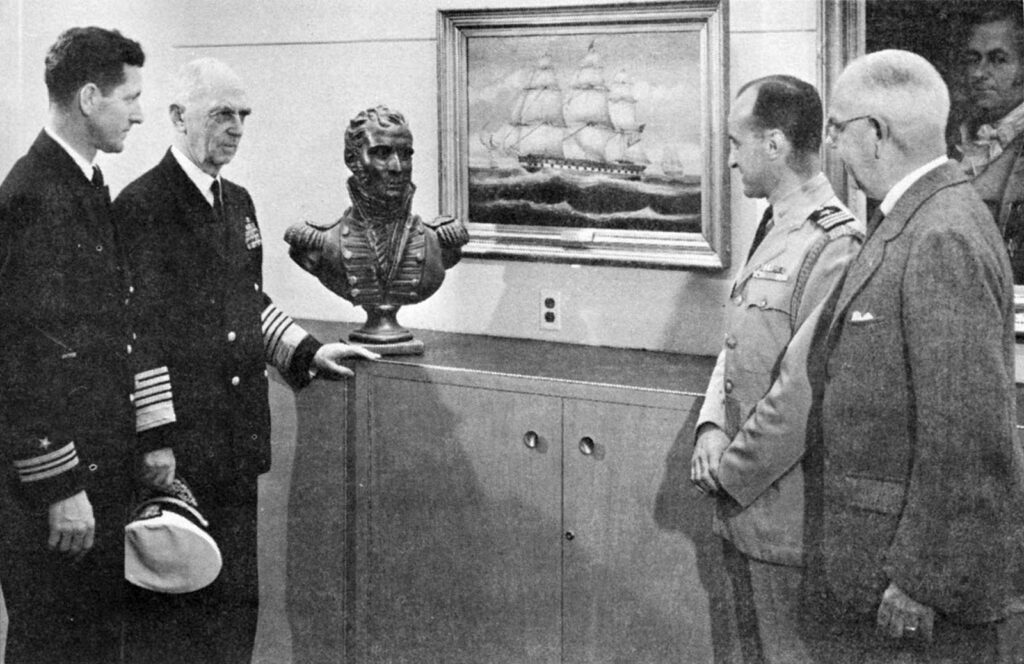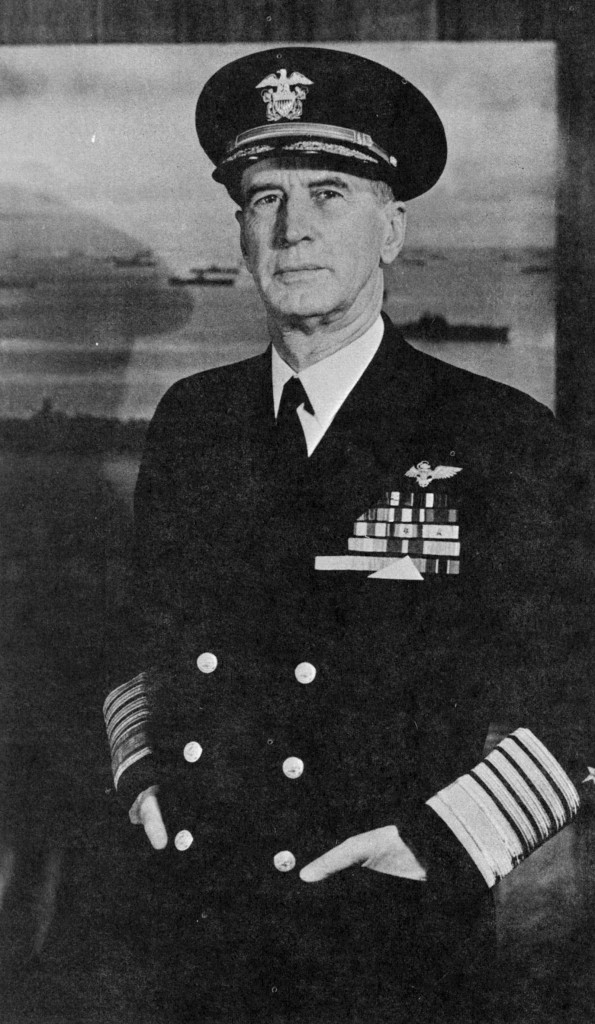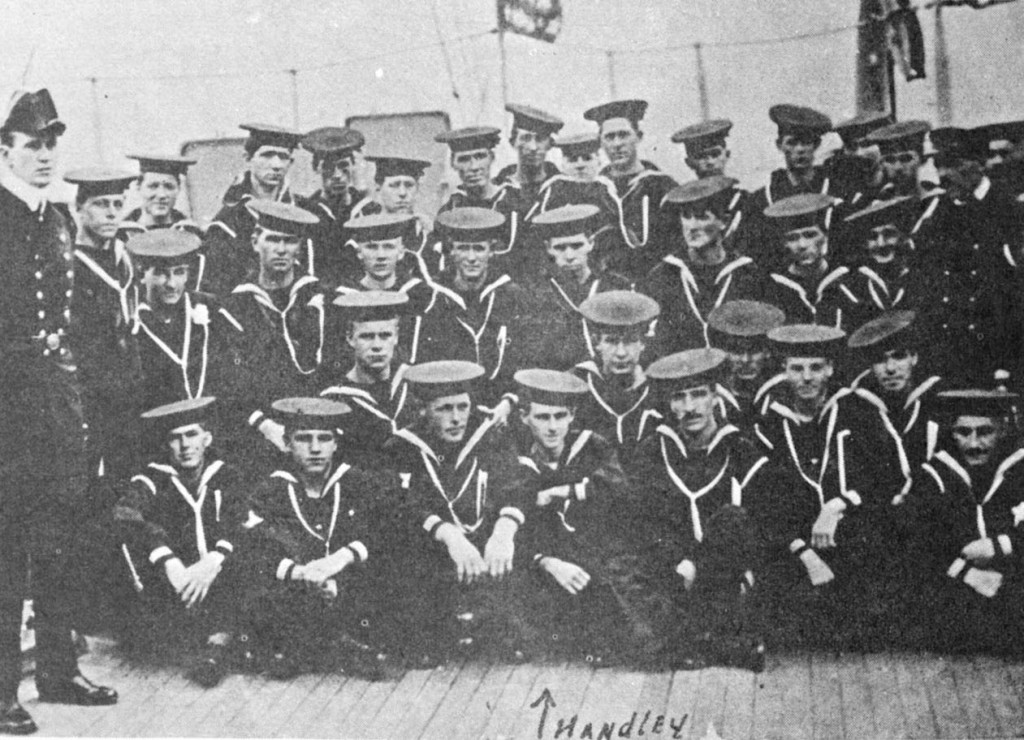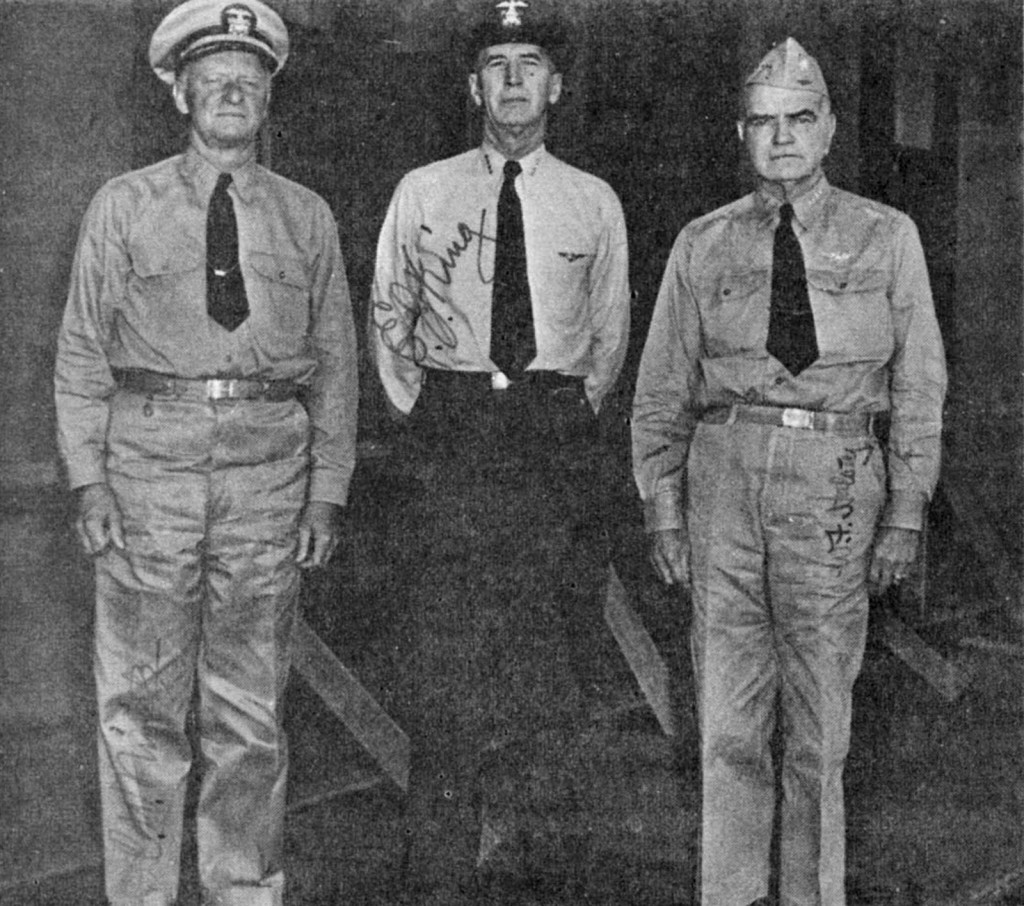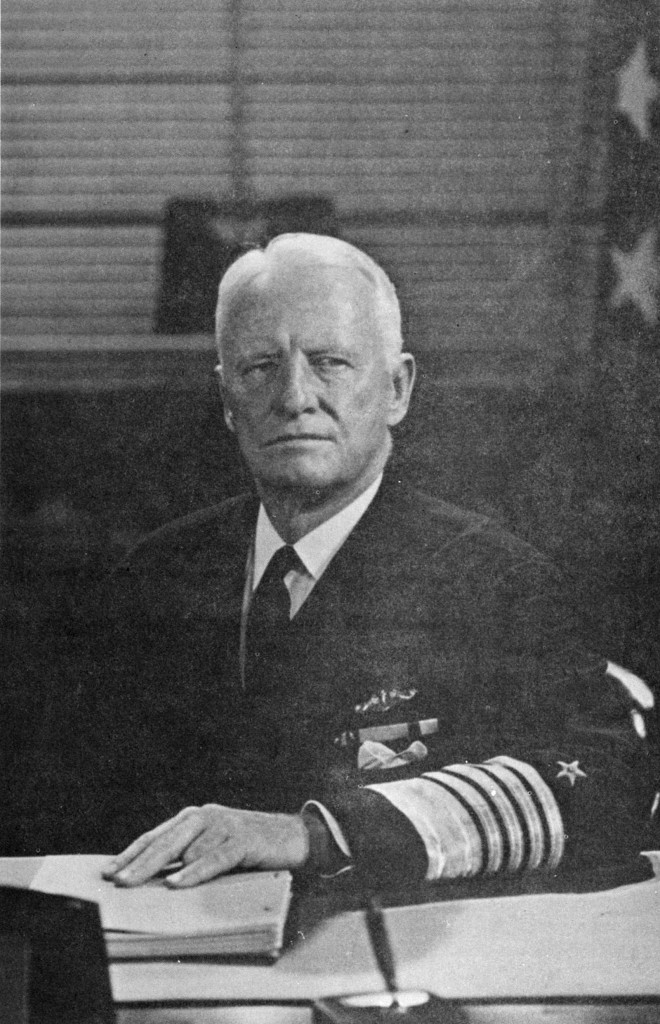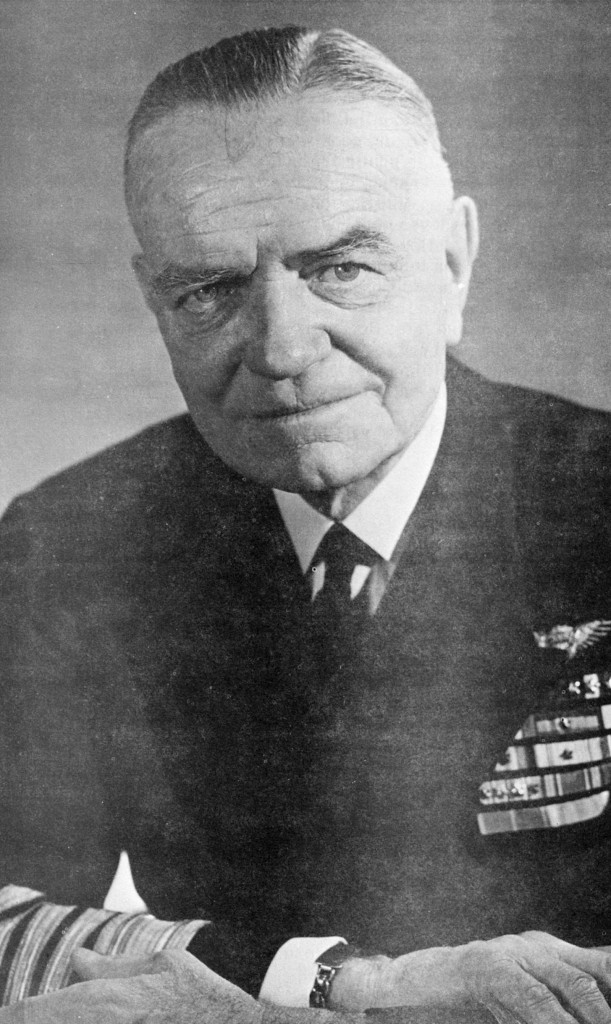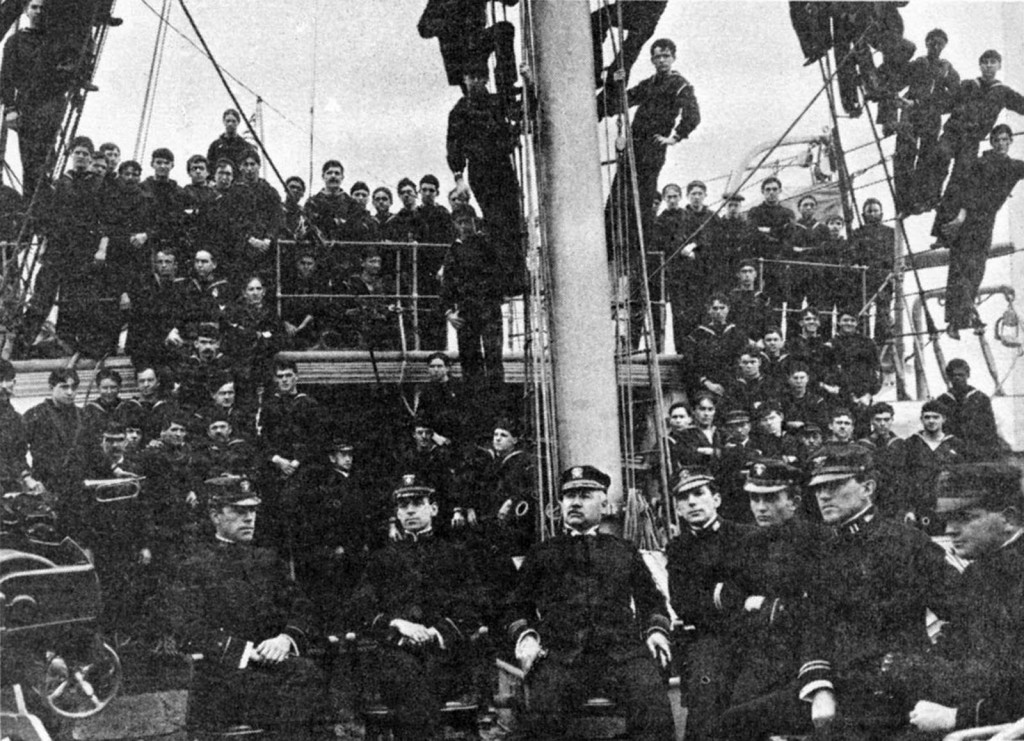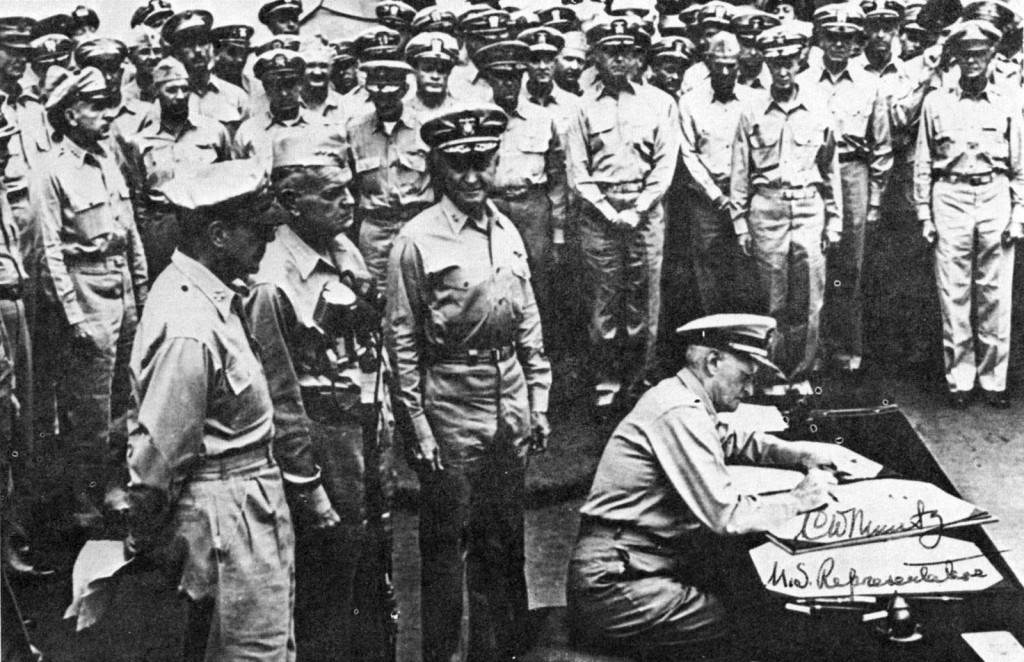A Naval Historical Foundation Publication, 1 August 1966
ORIGINAL TEXT OF PAMPHLET
NOTE: A correction was made in the pamphlet regarding Fleet Admiral William Leahy’s class rank. The correct information is included in the text below. (2/22/16)
By act of Congress approved 14 December 1944, the grade of Fleet Admiral, United States Navy, was established for certain officers on the active list of the Navy. Four officers were nominated by the president for that grade. With the advice and consent of the Congress, they were appointed by him and served in that grade until they died.
All of these officers were personally and actively interested in the Naval Historical Foundation and contributed much to its growth. Two of them, Fleet Admirals Leahy and King, were elected and served as active Presidents; one, Fleet Admiral Nimitz, residing on the west coast, was elected and served as an Honorary Vice President and later as the Foundation’s only Honorary President. Fleet Admiral Halsey, active in business in New York, was elected and served as an Honorary Vice President.
It is interesting to note that each of these officers followed a differently patterned naval career. Only eight years of seniority separated them. They served as younger officers when the Navy was making its expansion in aviation and submarine development. One of these officers was essentially a destroyer officer and aviator with only one short tour ashore in Washington. One other was a submariner with European training in Diesel propulsion, a big ship sailor with shore cruises in Washington including Chief of Naval Personnel. One had almost all his sea duty in big ships and with the exception of one tour, all shore duty in Washington, including Chief of two Bureaus. Only one had a seagoing career in the surface, submarine and aviation branches of the service with shore tours including the Head of the Post Graduate School and the Chief of the Bureau of Aeronautics. Three served as Chiefs of Naval Operations.
In these short summaries, the careers of four Five Star Admirals, the Foundation attempts to point out the types of duties they performed. They are not intended to be personal biographies. All material presented is from the official files of the Navy Department.
FLEET ADMIRAL WILLIAM DANIEL LEAHY
William Daniel Leahy was born in Hampton, Iowa, on May 6, 1875. His father, Michael Leahy, a lawyer, had been Captain of Wisconsin Infantry Volunteers during the Civil War. Young Leahy originally hoped to attend West Point, but there were no appointments available. When he completed high school in Ashland, Wisc., in 1893, he was able to win an appointment to the Naval Academy. He graduated in 1897, 35th in a class of 47.
Midshipman Leahy was assigned to USS Oregon, then in the Pacific. He was in that battleship when she made her famous dash around the horn in the Spring of 1898 to participate in the battle of Santiago on July 3.
Having completed the two years’ sea duty — then required by law — he was commissioned Ensign on 01 July 1899. At that time, he was on the Asiatic Station, where, during the Philippine Insurrection and the Boxer uprising in China, he served in USS Castine, USS Glacier and commanded the gunboat USS Mariveles. He returned to the United States in 1902, and for the next five years did duty in USS Tacoma and USS Boston which was stationed in Panama during the early period of construction of the canal.
His first shore cruise was at the Naval Academy. Beginning in 1907, he served as instructor in the Department of Physics and Chemistry for two years. He went to sea in 1909 and served as navigator of the armed cruiser USS California in the Pacific Fleet. During the American Occupation of Nicaragua in 1912, he was Chief of Staff to the Commander Naval Forces there.
Late in 1912, he came ashore in Washington as Assistant Director of Gunnery Exercises and Engineering Competitions. In 1913, he was assigned to the Bureau of Navigation as a detail officer where he served until 1915. At that time, he took command of the dispatch gunboat USS Dolphin, and established a very close friendship with the then-Assistant Secretary of the Navy Franklin D. Roosevelt, who cruised with him on the ship. He was in that assignment in early 1917 in West Indian waters and had additional duty as Senior Aide on the Staff of Commander Squadron Three of the Patrol Force Atlantic Fleet.
He served for almost a year as the Executive Officer of USS Nevada and in April 1918 went to command USS Princess Matotika, formerly Princess Alice , transporting troops to France.
After a short cruise in that command, he came ashore in 1918 and served for three years as director of Gunnery Exercises and Engineering Competition in the Navy Department, and as senior member of the Fire Control Board. In 1921, he went to sea in command of USS St. Louis, flagship of the Naval Detachment in Turkish waters during the war between Turkey and Greece. At the end of that war, he was given command of Mine Squadron One, and in 1922 further additional duty as commander, Control Force.
When he returned to the U.S. and from 1923 to 1926, he served as Director of Officer Personnel in the Bureau of Navigation, and then had one year in command of the battleship USS New Mexico. In 1927, he reached flag rank and became Chief of the Bureau of Ordnance. After almost four years, he went to sea in 1931 as Commander Destroyers Scouting Force. In 1933, he came ashore in Washington as Chief of the Bureau of Navigation for two years, when he went to sea as a vice admiral, and Commander Battleships Battle Force. In 1936, he hoisted his four-star flag in USS California and Commander in Chief Battle Force. He was appointed Chief of Naval Operations, took the oath of office in January 1937 to serve until August 1939 when he was placed on the retired list. On that occasion, President Roosevelt said “Bill, if we have a war, you’re going to be right back here helping me run it.”
Immediately following his retirement, Admiral Leahy was assigned the duties of Governor of Puerto Rico in September 1939. He served in that capacity until November 1940 when he was appointed U.S. Ambassador to France where he served from January 1941 until recalled in May 1942.
In July of that year, he was called back to active duty as Chief of Staff to the Commander in Chief, U.S. Army and Navy, the President of the United States. As such, he presided over the Joint Chiefs of Staff and, when our country was host, over the combined Chiefs. In December 1944, he accepted the appointment and was confirmed as the newly created rank of Fleet Admiral.
On 25 March 1949, the President accepted his resignation from that assignment. He continued on duty in an advisory capacity in the office of the Secretary of the Navy, and served as President of the Naval Historical foundation. He died on 20 July 1959.
PROMOTIONS
Graduated from the Naval Academy – Class of 1897
Ensign – 01 July 1899
Lieutenant (junior grade) – 01 July 1902
Lieutenant – 31 Dec. 1903
Lieutenant Commander – 15 Sept. 1909
Commander – 29 Aug. 1916
Captain – 01 July 1918
Rear Admiral – 14 Oct. 1927
Vice Admiral – 13 July 1935
Admiral – 02 Jan. 1937
Fleet Admiral – 15 Dec. 1944
DECORATIONS and AWARDS
Navy Cross
Distinguished Service Medal with two gold stars
Sampson Medal
Spanish Campaign Medal
Philippine Campaign Medal
Nicaraguan Campaign Medal (1912)
Mexican Service Medal
Dominican Campaign Medal
World War I Victory Medal with “Overseas” clasp
American Campaign Medal
World War II Victory Medal
National Defense Service Medal
FLEET ADMIRAL ERNEST JOSEPH KING
Ernest Joseph King was born in Lorain, Ohio, on November 23,1878. As a young boy he read an article in the Youth’s Companion about the Naval Academy which stimulated his interest towards a Navy career. Upon graduating from Lorain High School in 1897, he was appointed to the Naval Academy by Representative Kerr of the Fourteenth District of Ohio. When he left home, his father, a railway mechanic, gave him a round-trip railway pass in case he might change his mind. He never used the return portion, although he kept it for many years.
In the Summer of 1898, during the Spanish American War, King served as a Naval Cadet in the USS San Francisco, flagship of the Northern Patrol Squadron, for which he received his first decoration, the Sampson Medal. He graduated with distinction in the Class of 1901, and served the two years at sea — then required by law — before being commissioned Ensign on June 7, 1903.
His assignments during his first sea cruise included service in USS Eagle surveying Cienfriegas, Cuba, in USS Cincinnati, a protected cruiser in the Asiatic Fleet during the Russo-Japanese War, in USS Illinois, flagship of the European Squadron, and USS Alabama, flagship of the second Division of the Atlantic Fleet.
His first shore duty came in 1906 when he went to the Naval Academy as an instructor in Ordnance and Gunnery for two years, followed by one year on the Executive Staff. Officers who were midshipmen at that time still remember him as a strict but fair duty officer.
There followed another sea cruise of three years beginning as Aide on the Staff of Commander Battleship Division Two, Atlantic Fleet in USS Minnesota, one year as Engineer Officer of USS New Hampshire and one year on the Staff of the Commander in Chief Atlantic Fleet in USS Connecticut.
His next shore cruise started in 1912 in command of the Engineering Experimental Station at Annapolis. After two years, in l914, he went to sea again, this time in destroyers in command of USS Cassin, then as aide to Commander Torpedo Flotilla Atlantic Fleet, Commander Sixth Division of the Flotilla. In 1916 he went to the staff of Admiral H. T. Mayo on which he served during WWI while the Admiral was Commander in Chief, Atlantic Fleet.
In 1919, Admiral King, then a Captain, became head of the Postgraduate School at the Naval Academy. Following that tour of duty, he commanded USS Bridge for a short period. In July 1922, he commenced a series of assignments which placed him in intimate contact with submarine operations when he was assigned to duty on the staff of Commander Submarine Flotillas, Atlantic Fleet, and as Commander Submarine Division Eleven. In 1923 he took command of the Submarine Base at New London with additional duty as Naval Inspector of Ordnance in Charge of the Mine Depot there. It was during this period in September 1925 that he was in charge of the salvage of USS S-51 which was sunk off Block Island.
Having had sea duty in destroyers, submarines and battleships, Captain King now began his career in Naval Aviation which was then taking its place in the Fleet. In 1926 he took command of the aircraft tender USS Wright with additional duties as Senior Aide on the Staff of Commander Air Squadrons, Atlantic Fleet, In January of 1927, he reported to the Naval Air Station, Pensacola for flight training and was designated naval aviator 3368 in May of that year. He rejoined Wright on completion of this training. When USS S-4 was sunk in December of that year off Provincetown, however, he was again assigned to command of her salvage operations.
Upon completion he returned to his command of the Wright, and had a short cruise as Commander Aircraft Squadrons, Scouting Fleet, until 1928, when he went ashore as Assistant Chief of the Bureau of Aeronautics. In 1929 he assumed command of the Naval Air Station, Norfolk, Virginia. In June of 1930 he went to sea in command of USS Lexington for a two year cruise in that ship. He then had a year in the senior officers’ course at the Naval War College. In 1933, with the rank of Rear Admiral, he became the Chief of the Bureau of Aeronautics until 1936. During the next five years, except for the year 1940 on the General Board he commanded Aircraft Base Force, Aircraft Scouting Force, and as a Vice Admiral in 1938, Aircraft Battle Force. In February 1941, he was given the rank of Admiral as Commander in Chief, Atlantic Fleet and on 30 December of that year he became Commander-in-Chief, U. S. Fleet. In March 1942, the President by Executive Order, combined the office of Commander in Chief and the Chief of Naval Operations, and Admiral King assumed those combined duties on 18 March, when he relieved Admiral Stark as Chief of Naval Operations, the first and only officer to hold such an assignment. On 17 December 1944 he was advanced to the newly created rank of Fleet Admiral.
In 1945, when the position of Commander in Chief, U. S. Fleet ceased to exist, as an office established by the President pursuant to Executive Order 99635, Admiral King became Chief of Naval Operations in October of that year. In December he was relieved by Fleet Admiral Nimitz. From that time he served in an Advisory Capacity in the office of the Secretary of the Navy, and as President of the Naval Historical Foundation. He died at the Naval Hospital, Portsmouth, New Hampshire on 25 June 1956.
PROMOTIONS
Graduated from the Naval Academy – Class of 1901
Ensign – June 7, 1903
Lieutenant (junior grade) – June 7, 1906
Lieutenant – June 7, 1906
Lieutenant Commander – July 1, 1913
Commander – July 1, 1917
Captain – September 21, 1918
Rear Admiral – November 1, 1933
Vice Admiral – January 29, 1938
Admiral- February 1, 1941
Fleet Admiral – December 17, 1944
DECORATIONS AND AWARDS
Navy Cross
Distinguished Service Medal with two gold stars
Spanish Campaign Medal
Sampson Medal
Mexican Service Medal
Victory Medal, Atlantic Fleet Clasp
American Defense Service Medal, with bronze “A”
American Campaign Medal
World War II Victory Medal
National Defense Service Medal
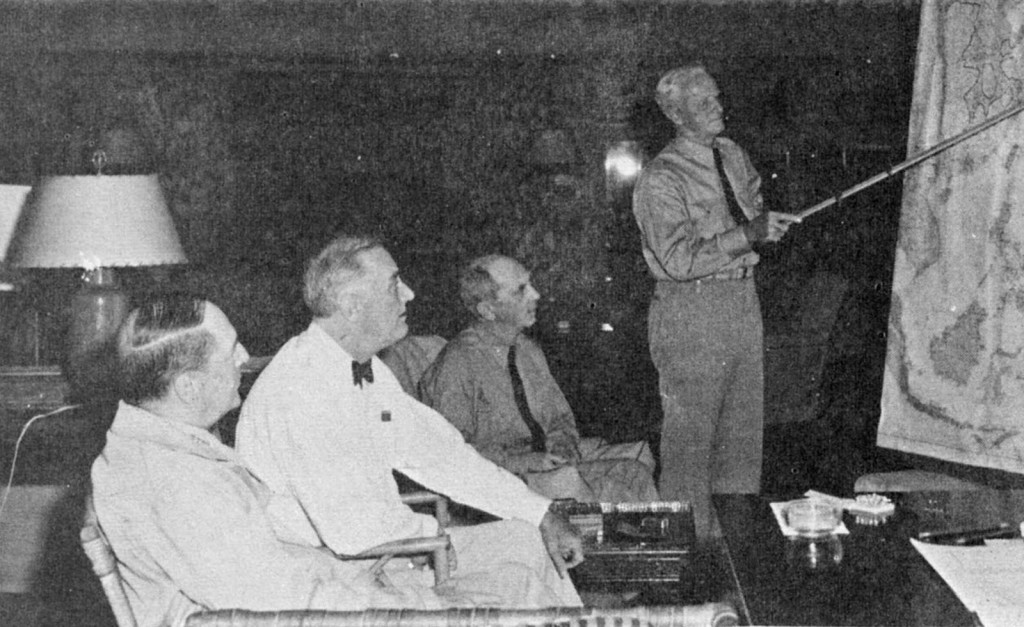
Admiral Nimitz points out the situation in the Pacific to General Douglas MacArthur, President Roosevelt, and Admiral Leahy at Pearl Harbor on 10 August 1944.
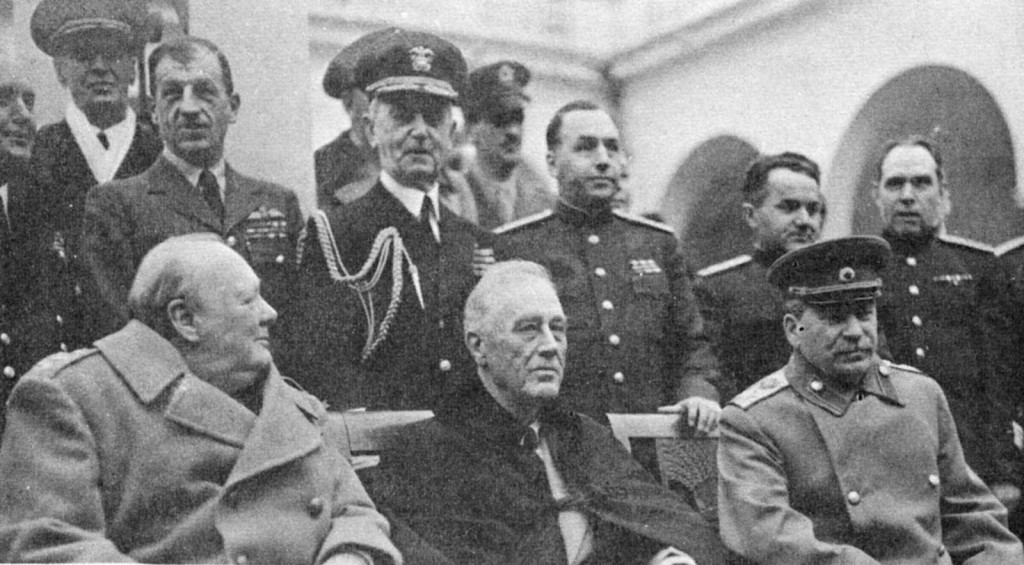
Conference of Big Three at Yalta on the Crimean Peninsula, February 4 to 12, 1945. Admiral King is standing, second from the left, and Admiral Leahy is the fourth from the left.
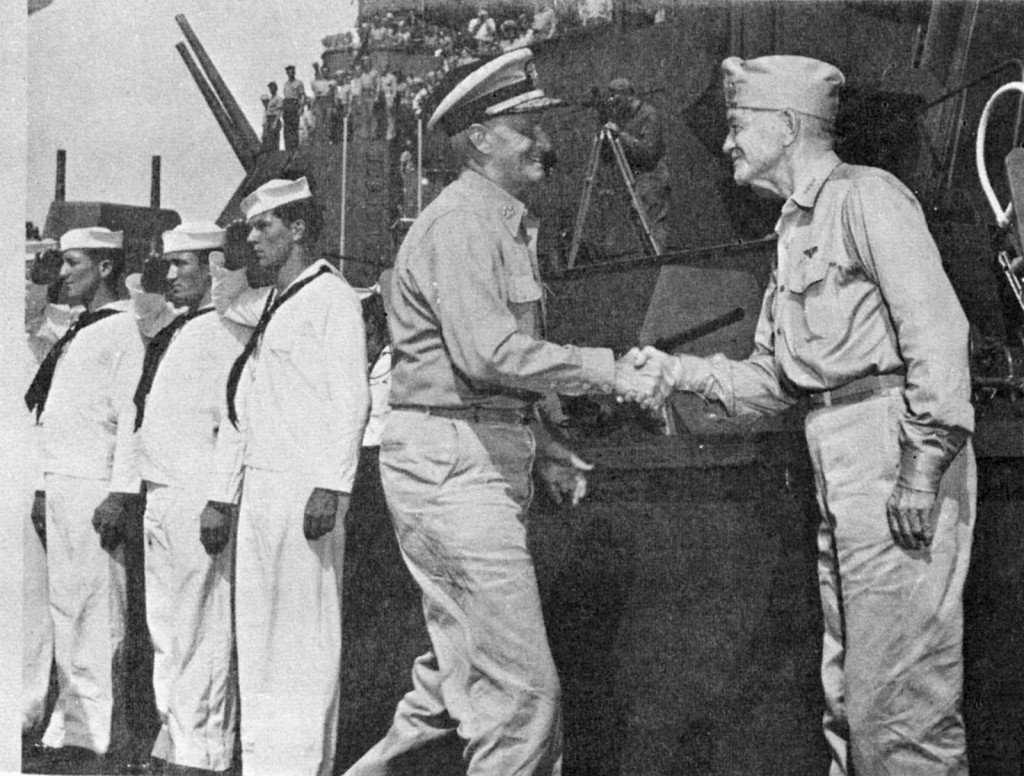
Fleet Admiral Nimitz is welcomed aboard USS SOUTH DAKOTA (BB-57) in Tokyo Bay by then Admiral Halsey on 29 August 1945.
FLEET ADMIRAL CHESTER WILLIAM NIMITZ
Chester William Nimitz was born on 24 February 1885, near a quaint hotel in Fredericksburg, Texas built by his grandfather, Charles Nimitz, a retired sea captain. Young Chester, however, had his sights set on an Army career and while a student at Tivy High School, Kerrville, Texas, he tried for an appointment to West Point. When none was available, he took a competitive examination for Annapolis and was selected and appointed from the Twelfth Congressional District of Texas in 1901.
He left high school to enter the Naval Academy Class of 1905. It was many years later, after he had become a Fleet Admiral that he actually was awarded his high school diploma. At the Academy Nimitz was an excellent student, especially in mathematics and graduated with distinction — seventh in a class of 114. He was an athlete and stroked the crew in his first class year. The Naval Academy’s yearbook, “Lucky Bag”, described him as a man “of cheerful yesterdays and confident tomorrows.”
After graduation he joined USS Ohio in San Francisco and cruised in her to the Far East. On 31 January 1907, after the two years’ sea duty then required by law, he was commissioned Ensign, and took command of the gunboat USS Panay. He then commanded USS Decatur and was court martialed for grounding her, an obstacle in his career which he overcame.
He returned to the U. S. in 1907 and was ordered to duty under instruction in submarines, the branch of the service in which he spent a large part of his sea duty. His first submarine was USS Plunger (A- 1). He successively commanded USS Snapper, USS Narwal and USS Skipjack until 1912. On 20 March of that year, Nimitz, then a Lieutenant, and commanding officer of the submarine E-1 (formerly Skipjack), was awarded the Silver Lifesaving Medal by the Treasury Department for his heroic action in saving W.J. Walsh, Fireman second class, USN, from drowning. A strong tide was running and Walsh, who could not swim, was rapidly being swept away from his ship. Lieutenant Nimitz dove in the water and kept Walsh afloat until both were picked up by a small boat.
He had one year in command of the Atlantic Submarine Flotilla before coming ashore in 1913 for duty in connection with building the diesel engines for the tanker USS Maumee at Groton, Conn. In that same year, he was sent to Germany and Belgium to study engines at their Diesel Plants. With that experience he subsequently served as Executive Officer and Engineering Officer of the Maumee until 1917 when he was assigned as Aide and Chief of Staff to COMSUBLANT. He served in that billet during World War I.
In September 1918 he came ashore to duty in the office of the Chief of Naval Operations and was a member of the Board of Submarine Design. His first sea duty in big ships came in 1919 when he had one year’s duty as Executive Officer of the battleship USS South Carolina. In 1920 he went to Pearl Harbor to build the submarine base there. Next assigned to the Naval War College, his studies of a possible Pacific Ocean war’s logistics would become extremely relevant two decades later.
In 1922 he was assigned as a student at the Naval War College, and upon graduation went as Chief of Staff to Commander Battle Forces and later Commander in Chief, U.S. Fleet (Admiral S. S. Robinson).
In the meantime, the ROTC program had been initiated and in 1926 he became the first Professor of Naval Science and Tactics for the Unit at the University of California at Berkley. Throughout the remainder of his life he retained a close association with the University. After three years in that assignment, in 1929, he again had sea duty in the submarine .service as Commander Submarine Division Twenty for two years and then went ashore to command the USS Regil and decomissioned destroyers at the base in San Diego. In 1933 he was assigned to his first large ship command, the heavy cruiser Augusta which served mostly as flagship of the Asiatic Fleet. Coming ashore in 1935 he served three years as Assistant Chief of the Bureau of Navigation. His next sea command was in flag rank as Commander Cruiser Division Two and then as Commander Battle Division One until 1939, when he was appointed as Chief of the Bureau of Navigation for four years. In December 1941, however, he was designated as Commander in Chief, Pacific Fleet and Pacific Ocean Areas, where he served throughout the war. On 19 December 1944, he was advanced to the newly created rank of Fleet Admiral, and on 1 September 1945, was the United States signatory to the surrender terms aboard the battleship Missouri in Tokyo Bay.
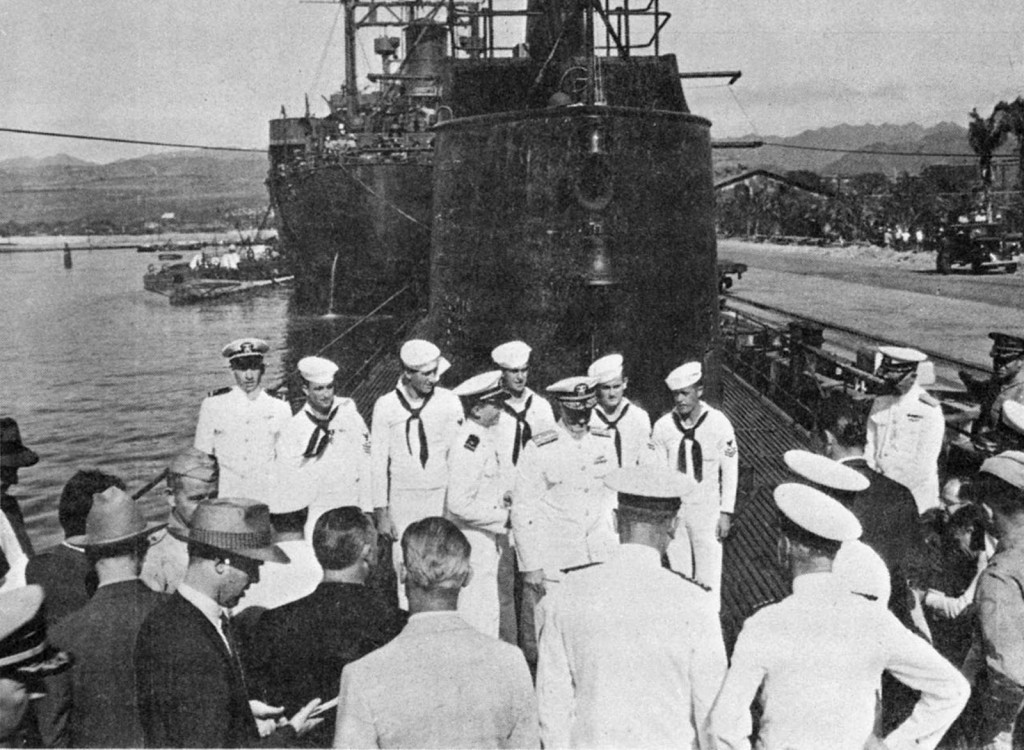
Admiral Nimitz assuming command as Commander-in-Chief Pacific Fleet on 31 December 1941 on board the USS GRAYLING (SS-209).
He hauled down his flag at Pearl Harbor on 26 Nov. 1945, and on 15 December relieved Fleet Admiral E.J. King as Chief of Naval Operations for a term of two years. On 01 January 1948, he reported as special Assistant to the Secretary of the Navy in the Western Sea Frontier. In March of 1949, he was nominated as Plebiscite Administrator for Kashmir under the United Nations. When that did not materialize he asked to be relieved and accepted an assignment as a roving goodwill ambassador of the United nations, to explain to the public the major issues confronting the U.N. In 1951, President Truman appointed him as Chairman of the nine-man commission on International Security and Industrial Rights. This commission never got underway because Congress never passed appropriate legislation.
Thereafter, he took an active interest in San Francisco community affairs, in addition to his continued active participation in affairs of concern to the Navy and the country. he was an honorary vice president and later honorary president of the Naval Historical Foundation. He served for eight years as a regent of the University of California and did much to restore goodwill with Japan by raising funds to restore the battleship Mikasa, Admiral Togo’s flagship at Tsushima in 1905.
He died on 20 February 1966.
PROMOTIONS
Graduated from the Naval Academy – Class of 1905
Ensign – 07 Jan. 1907
Lieutenant (junior grade) – 31 Jan. 1910
Lieutenant – 31 Jan. 1910
Lieutenant Commander – 29 Aug. 1916
Commander – 8 March 1918
Captain – 02 June 1927
Rear Admiral – 23 June 1938
Vice Admiral – Not held – promoted directly to Admiral
Admiral – 31 Dec. 1941
Fleet Admiral – 19 Dec. 1944
DECORATIONS and AWARDS
Distinguished Service Medal with two gold stars
Army Distinguished Service Medal
Silver Lifesaving Medal
Victory Medal with Escort Clasp
American Defense Service Medal
Asiatic-Pacific Campaign Medal
World War II Victory Medal
National Defense Service Medal
FLEET ADMIRAL WILLIAM FREDERICK HALSEY, JR.
William Frederick Halsey, Jr., was born in Elizabeth, New Jersey, on October 30, 1882, the son of the late Captain William F. Halsey, U. S. Navy. As a Navy junior, he made the usual round of schools prior to his appointment to the Naval Academy. President McKinley gave him an appointment in 1900.
While at the Naval Academy he distinguished himself in class committees and athletics, but not in scholarship. He was a member of the “Lucky Bag” yearbook staff, won his letter in football as a fullback and was president of the Athletic Association. As a First Classman, he had his name engraved on the Thompson Trophy Cup as the Midshipman who had done the most during the year for the promotion of athletics.
Upon graduation in February 1904, he was assigned to USS Missouri and later transferred to USS Don Juan de Austria in which he was commissioned an Ensign after having completed the two years at sea — then required by law. In 1907, he joined USS Kansas and made the famous World Cruise of the Fleet in that battle ship.
For the next almost 25 years practically all his sea duty with the Fleet was in destroyers, starting in 1909 with command of USS DuPont (TB-7 commissioned in 1897), USS Lamson, USS Flusser and USS Jarvis. In 1915 he went ashore for two years of duty in the Executive Department at the Naval Academy.
During WWI he served in the Queenstown Destroyer Force in command of USS Benham and USS Shaw. From 1918 to 1921 he continued his destroyer service in command of USS Yarnell, USS Chauncey, USS John Francis Burnes and Destroyer Division Thirty-two. In October of 1920 he assumed command of USS Wickes and of Destroyer Division Fifteen. At that time a destroyer division commander also commanded the division flagship. Another shore cruise sent him to duty in the Office of Naval Intelligence, in Washington, — which was his only duty assignment in that city. In October 1922, he was ordered as Naval Attache at the American Embassy in Berlin, Germany. One year later, he was given additional duty as Naval Attache at the American Embassies in Christiana, Norway; Copenhagen, Denmark; and Stockholm, Sweden.
On completion of that cruise he returned to sea duty, again in the destroyers in European waters, in command of USS Dale and USS Osborne. Upon his return to the U.S. in 1927, he served one year as Executive Officer of the battleship USS Wyoming — and then for three years in command of USS Reina Mercedes, station ship at the Naval Academy. He continued his destroyer duty on his next two-years at cruise starting in 1930 as Commander Destroyer Division Three of the Scouting Force. In 1932 he went as a student to the Naval War College.
Then in 1934, he embarked on his aviation career when he reported to the Naval Air Station, Pensacola for flight training. He was designated a Naval Aviator on 15 May 1935, and went in command of the carrier USS Saratoga for two years, followed by one year in command of the Naval Air Station, Pensacola.
In 1938, when he reached flag rank, he held successive commands of Carrier Division Two in USS Yorktown and Carrier Division One in Saratoga. In 1940, he became Commander Aircraft Battle Force with the rank of Vice Admiral. He was in USS Enterprise in that command when World War II broke out. In April 1942 he was designated Commander Task Force Sixteen, in Enterprise to escort the carrier USS Hornet to within 800 miles of Tokyo to launch the Army planes for the initial bombing of Japan.
In October 1942 he was made Commander South Pacific Forces and South Pacific Area. With the rank of Admiral, and for the next 18 months he was in command of that area during the offensive operations of the U. S. Forces. In June 1944 he assumed command of the Third Fleet, and was designated Commander Western Pacific Task Forces. As such, he operated successfully against the Japanese in the Palaies, Philippines, Formosa, Okinawa and South China Sea. Subsequent to the Okinawa campaign in July 1945, his forces struck at Tokyo and the Japanese mainland. The last attack of his forces was on 13 August 1945. Admiral Halsey’s flag was flying on USS Missouri on 2 September in Tokyo Bay when the formal Japanese surrender was signed onboard.
Immediately thereafter, 54 ships of the Third Fleet, with his four-star flag in USS South Dakota, returned to the United States for annual Navy Day Celebrations in San Francisco on 27 October 1945. He hauled down his flag in November of that year and was assigned special duty in the office of the Secretary of the Navy. On December 11, 1945, he took the oath as Fleet Admiral becoming the fourth and last officer to hold the rank.
Later, Fleet Admiral Halsey made a goodwill flying trip through Central and South America covering nearly 28,000 miles, and 11 nations. He was relieved of active duty in December 1946, and upon his own request transferred to the retired list on 1 March 1947.
Upon retirement, he joined the board of two subsidiaries of the International Telephone and Telegraph Company and served until 1957. He was active in an unsuccessful effort to preserve the USS Enterprise as a national shrine, and was an elected Honorary Vice President of the Naval Historical Foundation.
He died on 16 August 1959 at Fishers Island Country Club.
PROMOTIONS
Graduated from Naval Academy – Class of 1904
Ensign – February 2, 1906
Lieutenant (junior grade) – February 2, 1909
Lieutenant – February 2, 1909
Lieutenant Commander – August 29, 1916
Commander – February 1, 1918
Captain – February 10, 1927
Rear Admiral – March 1, 1938
Vice Admiral – June 13, 1940
Admiral – November 18, 1942
Fleet Admiral – December 11, 1945
DECORATIONS AND AWARDS
Navy Cross
Distinguished Service Medal with three gold stars
Army Distinguished Service Medal
Presidential Unit Citation
Mexican Service Medal
Victory Medal, Destroyer Clasp
American Defense Service Medal with Fleet Clasp
Asiatic-Pacific Campaign Medal
World War II Victory Medal
National Defense Service Medal
Philippine Liberation Medal

